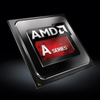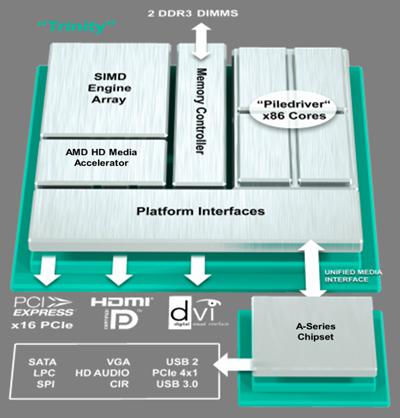Turbo core and North bridge
Turbo Core 3.0
A feature that started at AMD's Phenom II Hexacore processors is of course AMD Turbo Core. Llano got it, Trinity and Richland APUs will get AMD Turbo Core enabled as well and that means that the processor can throttle the clock frequency of the CPU cores independently above the base clock frequency for a short period of time. We are now at revision 3.0 of this implementation. The APU constantly measures factors like threaded workload, power limitations, voltages and heat levels for both the CPU and GPU. Based on algorithms, the clock frequency of the CPU cores will change. If you are using Photoshop and apply a filter, then for a short burst the Turbo Core mode will kick in and accelerate the CPU cores' clock frequency a little higher. Should you use the GPU in Photoshop (creates more load/heat) then that Turbo mode forfeits and makes sure the processor cores remain at their reference clock frequency.
The A10-6790 APU for example has a base clock of 4100 MHz but it can Turbo towards 4300 MHz. Revision 3.0 of the Turbo has been implemented to be as efficient as can be, the CPU and GPU will switch really clever in-between themselves. If you need a little more CPU power, then the GPU will get a little less. The second the GPU needs a little more juice, the CPU can clock down a notch.
Northbridge
We explained that the APU architecture has a lot more inside of it than just the CPU and GPU, there's core logic for the UVD engine but also high-level Northbridge functionality including a PCI-Express 2.0 controller and a dual-channel DDR3 memory controller. That memory controller is again based on the Bulldozer architecture but optimized to support higher frequency memory. This was needed to give the GPU harbored inside the A10 APU as much memory bandwidth as possible. So, straight out of the box higher memory DDR3 frequencies are supported. The Richland dual-channel memory controller as such supports DDR3 memory up-to 2133 MHz. Hey, for graphics the generic rule is simple; the faster the frame buffer memory the better. Integrated into the Northbridge is also a PCI-Express 2.0 controller that comes with 24 available lanes. You can use 16 for a dedicated graphics card. Four PCI-Express lanes will be used connecting to the FCH chipset, the data that has to be sent back and forth between the Trinity APU and the FCH (SouthBridge Fusion Controller Hub) uses a so-called UMI link which is basically a fourth PCI Express x4 interface that provides 2GB/s worth of bandwidth in each direction. The residual four links can be used for extra controllers like audio, Ethernet or USB 3.0.


